Complete Analysis of Trump's Anti-Trans Order
On Sunday, reports emerged that President Trump would unleash a series of sweeping executive orders upon taking office, with one of the most significant targeting transgender people. By Monday evening, that prediction became reality. President Trump signed an executive order titled “Defending Women From Gender Ideology Extremism and Restoring Biological Truth to the Federal Government,” a comprehensive directive aimed squarely at dismantling legal and social recognition of transgender people across the United States.
This far-reaching order impacts nearly every aspect of transgender lives, from federal identification to education, healthcare, and workplace protections. Its scope and implications demand immediate attention—not just from transgender individuals, but also their allies, journalists covering LGBTQ+ issues, and policymakers representing vulnerable communities. Understanding the full extent of this order, its potential limitations, and how it fits into the broader anti-trans strategy sweeping the nation is essential.
This analysis will go section by section to make clearer what the order does and does not do.
This section of the executive order has no legal weight but provides insight into its purpose and ideological roots. The Trump administration makes clear that it views transgender people as an enemy, framing their existence as an “attack” on women and institutions, much like opponents of gay marriage once framed it as an attack on the sanctity of marriage. On substance, the section makes its purpose clear: to remove transgender women from women’s spaces and to end federal recognition of transgender people broadly, while entirely ignoring the existence of transgender men and focusing its fear-mongering heavily on transgender women.
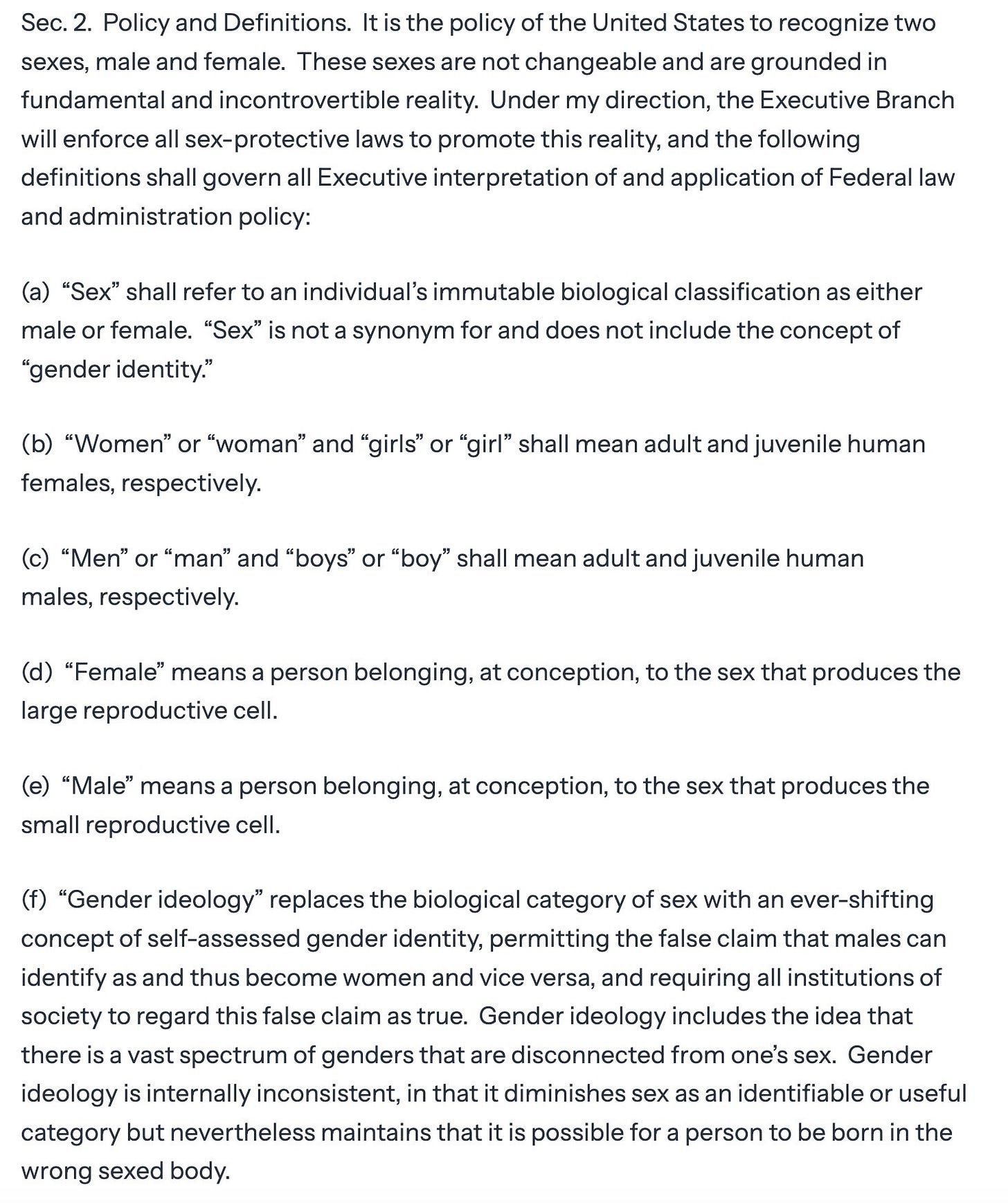 |
This section, called the definition section, may appear to have little immediate legal impact, but its potential application across Trump’s government is vast and far-reaching. Drawing from a type of legislation spreading across heavily Republican states, often referred to as a “Women’s Bill of Rights,” these definitions ironically grant no new rights to women but instead aim to establish definitions of sex that effectively erase the legal existence of transgender people. Under Trump’s executive order, this section defines terms like “male” and “female” in ways that could fundamentally reshape how laws, policies, and regulations are applied throughout federal agencies.
The practical implications are enormous. These definitions form the foundation for the rest of the executive order, serving as a directive for every federal agency to reinterpret and enforce their policies through this narrow and reductive lens. For instance, the Department of Education could use this definition to exclude transgender women from Title IX protections. The Department of Veterans Affairs could apply it to mandate bathroom signs based on perceived “biological sex.” These are just a few examples of how these definitions could trickle down into agency decisions, potentially impacting countless aspects of daily life for transgender people.
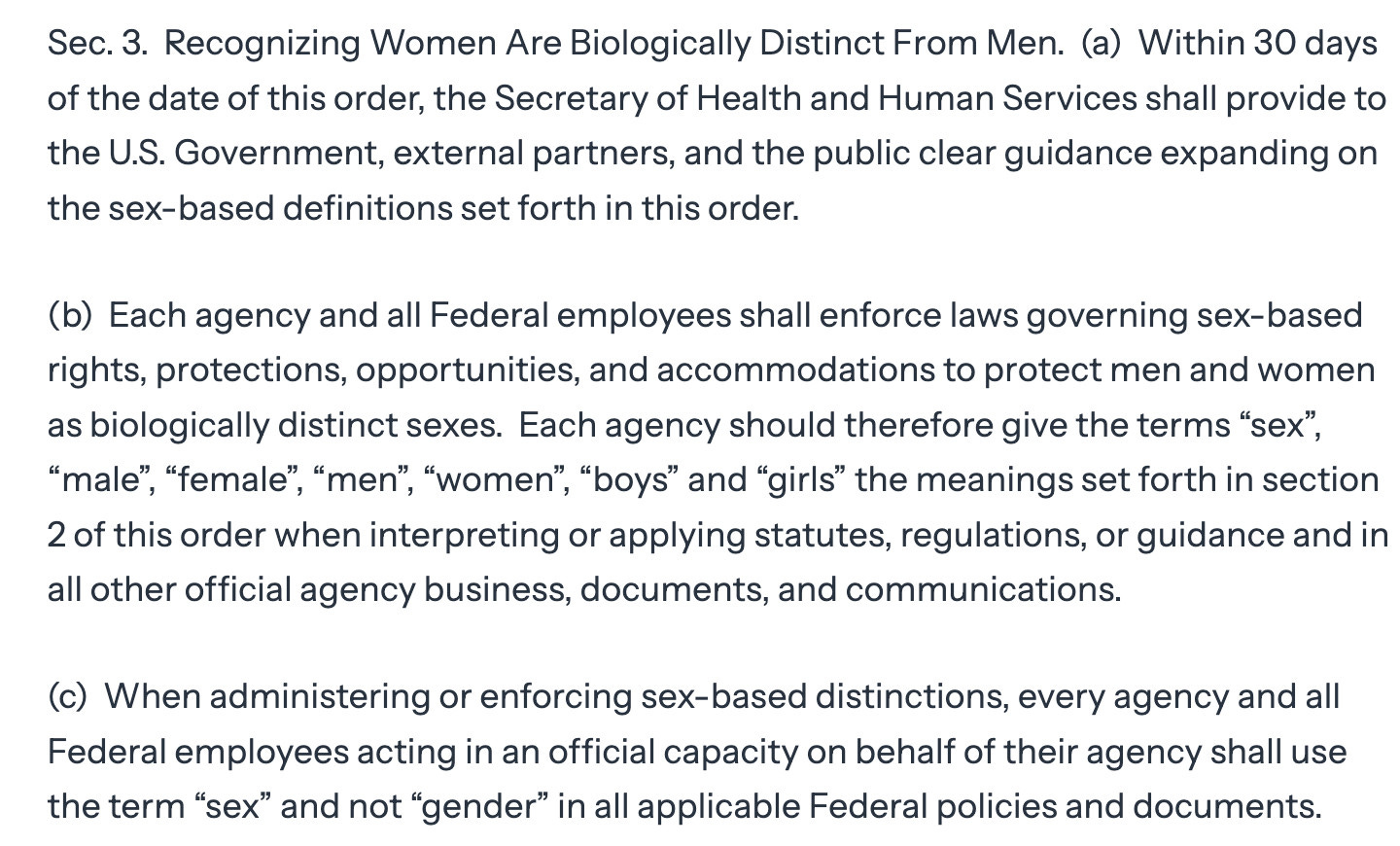 |
While this section alone lacks direct enforcement power, it establishes the framework through which Trump’s administration will define and regulate gender, effectively framing how the government will view and treat transgender individuals in every policy and decision moving forward.
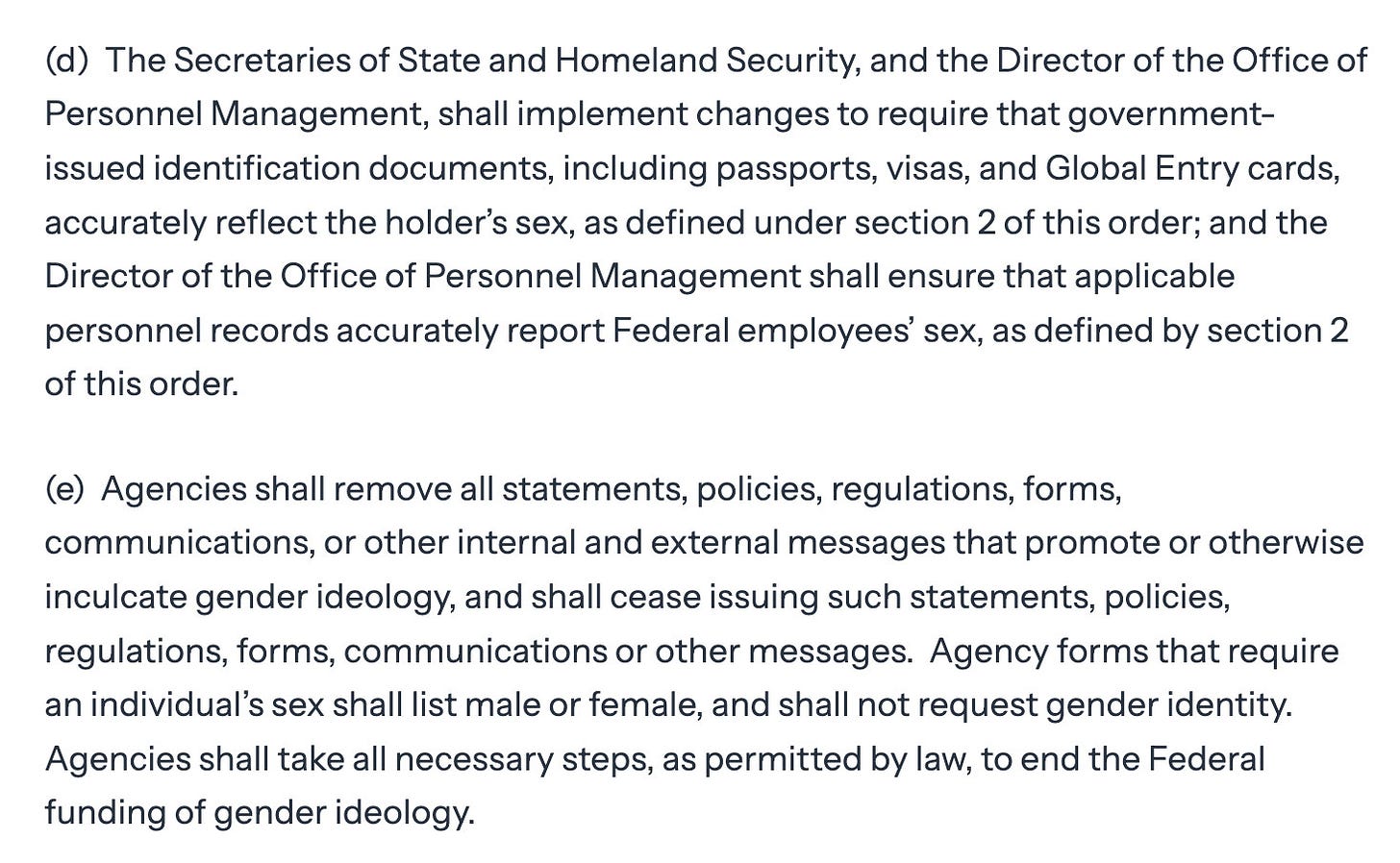 |
This section of the executive order is designed explicitly to enforce the defined terms of sex across federal agencies and employees. It mandates that these definitions be applied in the interpretation of all “statutes, regulations, guidance,” as well as in “agency business, documents, and communications.” Additionally, it assigns significant responsibility to the Secretary of Health and Human Services, tasking the department with leading the development of guidance for other federal agencies on how to implement and adhere to these definitions in their operations.
This section marks the first directly impactful provision of the executive order, targeting federal documentation. It mandates that passports, visas, and global entry cards must reflect “sex” as defined in the earlier section of the order. The specifics of implementation remain unclear. Questions linger over whether the policy will apply only to new documents or if existing passports will be retroactively altered. Notably, an NBC correspondent reported that a legal expert advised caution for those holding nonbinary X markers, suggesting that such passports could potentially be confiscated or replaced when traveling internationally—though Erin In The Morning has been unable to independently confirm this interpretation.
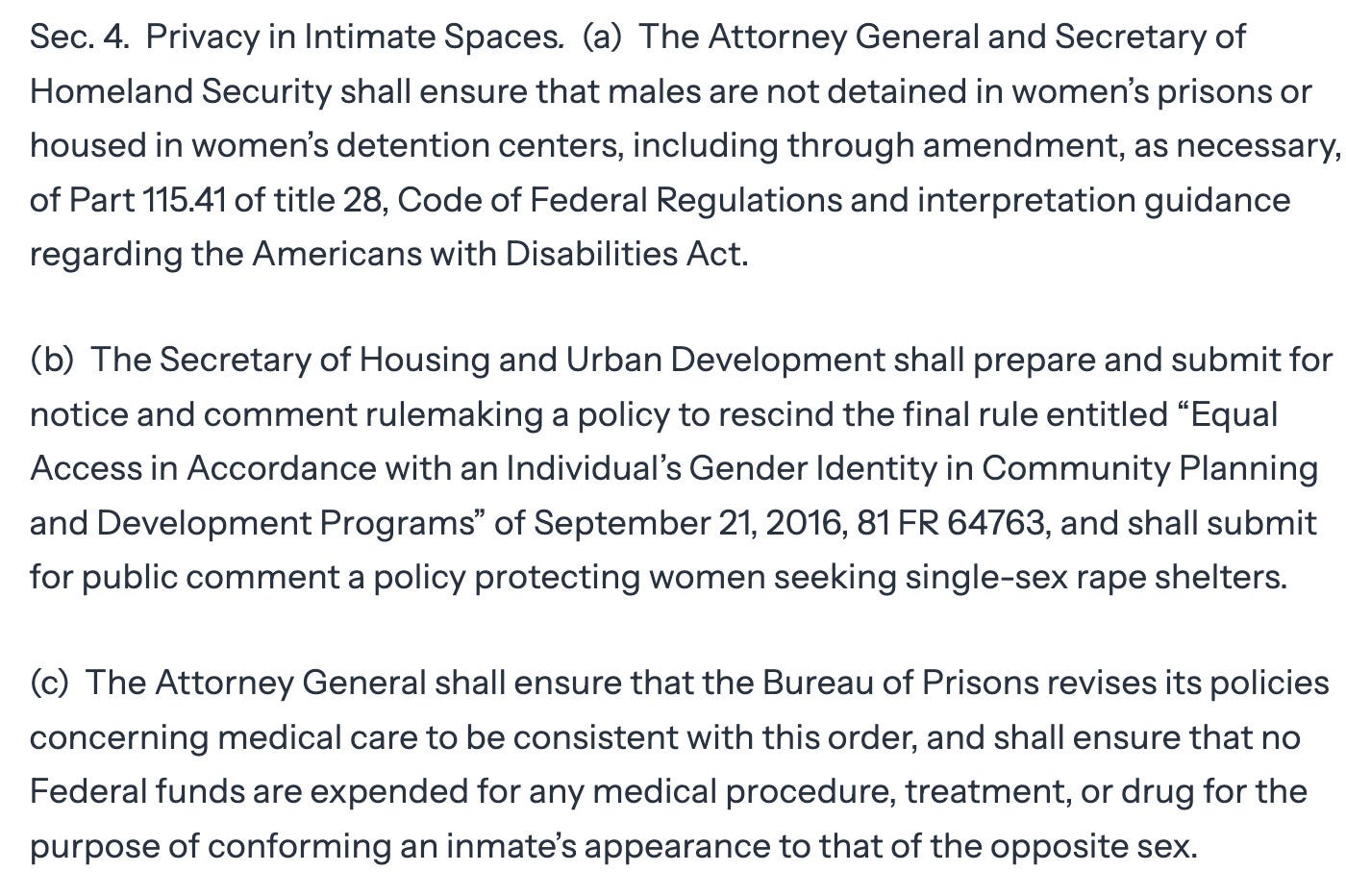 |
In some states, similar policies have already resulted in confiscations and replacements of driver’s licenses. Last year, Florida’s Department of Highway Safety and Motor Vehicles announced that gender changes would no longer be allowed on driver’s licenses under a similar policy, warning that misrepresenting one’s gender could constitute fraud. This policy led directly to the cancellation of a transgender woman’s driver’s license after she updated her gender marker. Similar measures have also been enacted in Texas and Kansas. However, implementing such policies on a federal level may prove more complex and time-consuming, particularly for transgender people who have already updated their passports under previous guidelines.
This section, titled “Privacy in Intimate Spaces,” would have significant impacts on women’s detention facilities, prisons, and other similar environments. It mandates that males—defined by the executive order to include transgender women—be barred from women’s detention centers. Additionally, it prohibits the use of federal funding for gender-affirming care in those spaces.
 |
Policies like these have already been enacted in Florida, where transgender women in custody face severe treatment. They have had their heads forcibly shorn, feminine items confiscated, and been subjected to government-mandated conversion therapy. In one Florida case, a judge went so far as to describe transgender inmates as individuals experiencing “short-term delusions.” If implemented federally, this executive order could extend those draconian practices to prisons across the United States.
This subsection, though brief, represents a potentially significant and impactful change under the executive order. If any part of this order directly leads to a federal bathroom ban targeting transgender individuals, this section is the most likely catalyst. It mandates that federal agencies ensure “intimate spaces” are designated by sex as defined earlier in the order, rather than by gender identity. This provision could be used to enforce a federal bathroom ban, mirroring Speaker Mike Johnson’s bathroom ban in United States House facilities.
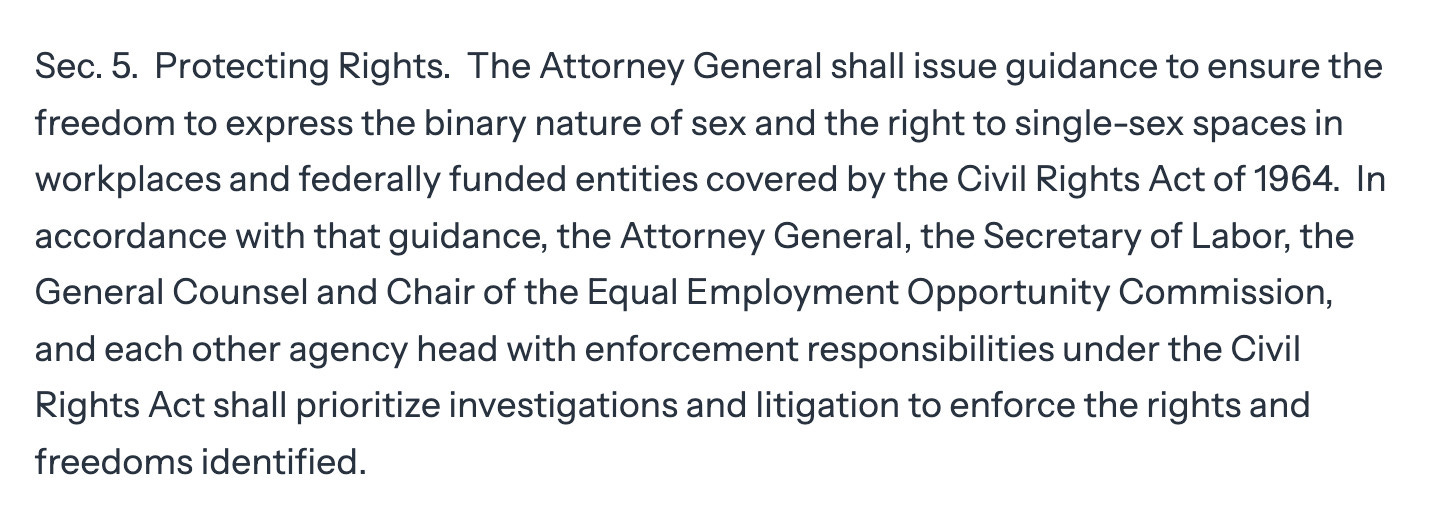 |
The implications could extend to federal facilities nationwide, including National Parks, Washington D.C. museums, airports such as Dulles and Reagan, VA hospitals, and more. While it remains unclear how or if such a policy will be enforced, the potential for restrictions in these spaces is significant and warrants close monitoring.
 |
Several sections of the executive order reference the Equal Employment Opportunity Commission (EEOC), signaling a potential attempt to weaponize the agency against transgender people using restrooms aligned with their gender identity in the workplace. Similar proposals have appeared in state legislatures, such as in Missouri, but these bills have largely failed to gain traction. However, this section merits close attention, as the administration could potentially argue that existing nondiscrimination laws require enforcing discrimination against transgender individuals in workplace restrooms, setting a dangerous precedent.
The final section of the executive order is a sweeping rollback of several positive pieces of guidance issued by the Biden administration regarding LGBTQ+ protections. It rescinds Title IX guidance that protects transgender individuals, guidance to schools aimed at addressing anti-LGBTQ+ bullying, and protections for intersex youth. Additionally, it reverses guidance on applications of Bostock v. Clayton County to workplace protections and eliminates other workplace protection guidelines. This section underscores the administration's intent to dismantle federal protections for LGBTQ+ people.
Ultimately, while the executive order is undeniably sweeping in scope and potential impact, many of its provisions will not take immediate effect. Implementation will require time, navigating complex rulemaking processes, and will almost certainly face legal challenges that could delay enforcement for months or even years. However, the executive order package provides a clear blueprint for where the Trump administration intends to target transgender rights. Its ultimate effectiveness—or lack thereof—will hinge on the resistance it encounters, both in courts and from broader societal opposition.


Comments